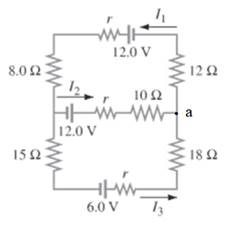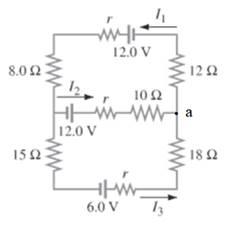
Concept explainers
(a)
The magnitude of the current
(a)
Answer to Problem 32P
The magnitude of the current is
Explanation of Solution
Given information:
Consider the given circuit.

The value of the internal resistance is
Formula used:
Apply Kirchhoff’s voltage law in the circuit to determine the currents.
Calculation:
Apply Kirchhoff’s voltage law in the upper loop.
Apply Kirchhoff’s voltage law in the lower loop.
At node (a), apply Kirchhoff’s current law.
Substitute the value of
On solving equations (1) and (4),
Substitute the values in equation (3).
Therefore, themagnitude of the current is
(b)
The terminal voltage of the 6-volt battery.
(b)
Answer to Problem 32P
The terminal voltage of the 6-volt battery is
Explanation of Solution
Given information:
Consider the given circuit.

Formula used:
From part (a), the magnitude of the current is
Calculate the terminal voltage of 6-volt battery.
Therefore, the terminal voltage of the 6-volt battery is
Chapter 19 Solutions
Physics: Principles with Applications
Additional Science Textbook Solutions
Modern Physics
Sears And Zemansky's University Physics With Modern Physics
College Physics
College Physics
Physics for Scientists and Engineers with Modern Physics
Conceptual Physics (12th Edition)
 College PhysicsPhysicsISBN:9781305952300Author:Raymond A. Serway, Chris VuillePublisher:Cengage Learning
College PhysicsPhysicsISBN:9781305952300Author:Raymond A. Serway, Chris VuillePublisher:Cengage Learning University Physics (14th Edition)PhysicsISBN:9780133969290Author:Hugh D. Young, Roger A. FreedmanPublisher:PEARSON
University Physics (14th Edition)PhysicsISBN:9780133969290Author:Hugh D. Young, Roger A. FreedmanPublisher:PEARSON Introduction To Quantum MechanicsPhysicsISBN:9781107189638Author:Griffiths, David J., Schroeter, Darrell F.Publisher:Cambridge University Press
Introduction To Quantum MechanicsPhysicsISBN:9781107189638Author:Griffiths, David J., Schroeter, Darrell F.Publisher:Cambridge University Press Physics for Scientists and EngineersPhysicsISBN:9781337553278Author:Raymond A. Serway, John W. JewettPublisher:Cengage Learning
Physics for Scientists and EngineersPhysicsISBN:9781337553278Author:Raymond A. Serway, John W. JewettPublisher:Cengage Learning Lecture- Tutorials for Introductory AstronomyPhysicsISBN:9780321820464Author:Edward E. Prather, Tim P. Slater, Jeff P. Adams, Gina BrissendenPublisher:Addison-Wesley
Lecture- Tutorials for Introductory AstronomyPhysicsISBN:9780321820464Author:Edward E. Prather, Tim P. Slater, Jeff P. Adams, Gina BrissendenPublisher:Addison-Wesley College Physics: A Strategic Approach (4th Editio...PhysicsISBN:9780134609034Author:Randall D. Knight (Professor Emeritus), Brian Jones, Stuart FieldPublisher:PEARSON
College Physics: A Strategic Approach (4th Editio...PhysicsISBN:9780134609034Author:Randall D. Knight (Professor Emeritus), Brian Jones, Stuart FieldPublisher:PEARSON





